Growing carrots in raised beds offers a multitude of benefits. It’s a method that allows you to control your soil quality better, making it easier to provide your carrots with the nutrient-rich environment they crave. Plus, it’s a fantastic way to maximize your gardening space, especially if you’re working with a smaller area.
Growing carrots in raised beds is a gardening method that provides ideal conditions for this root vegetable. Raised beds offer deep, loose, and well-drained soil, which is perfect for the growth and development of carrot roots. The beds also allow for better control over soil composition and moisture levels. Plant carrot seeds directly into the raised bed, maintain consistent moisture, and ensure proper spacing for optimal growth. With proper care, you’ll have a bountiful harvest of homegrown carrots.
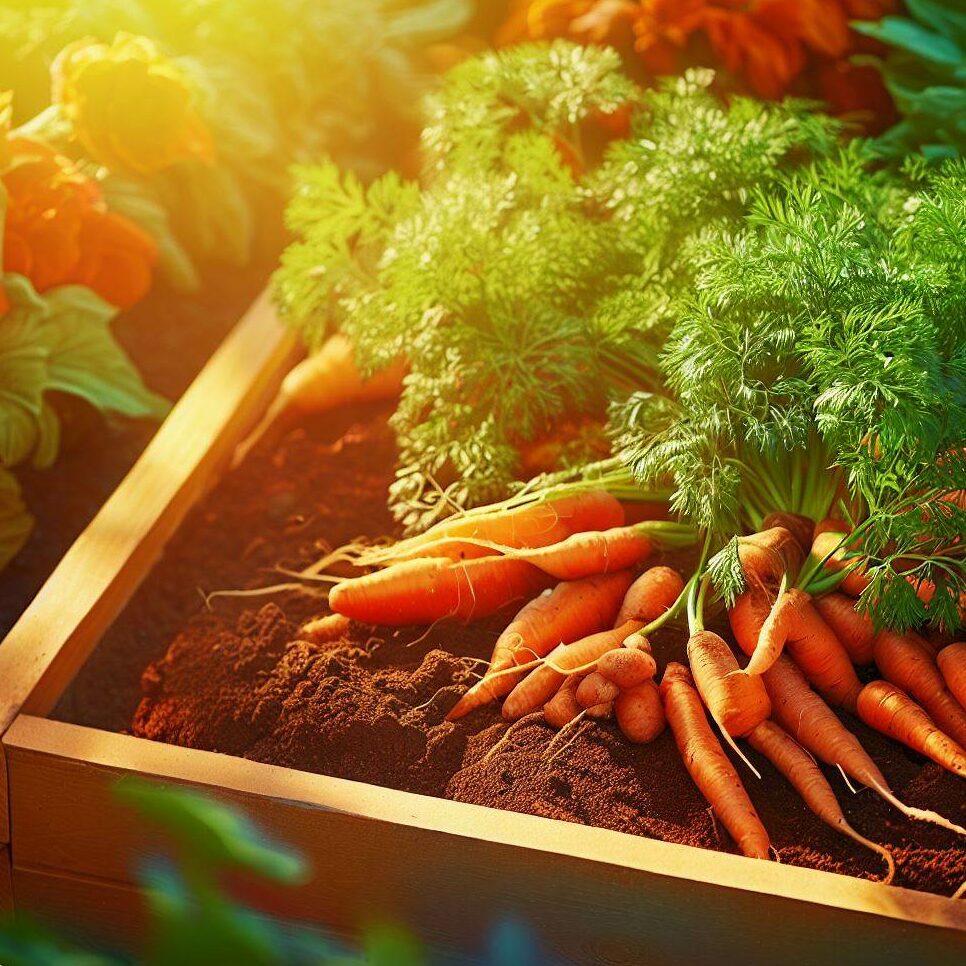
Why Choose Raised Beds?
Here are a few reasons why this method is a favorite among gardeners:
- Improved Soil Conditions: Raised beds allow for better drainage and prevent soil compaction, creating an ideal environment for carrot growth.
- Easier Maintenance: With raised beds, weeding and pest control become less of a chore. Plus, they’re easier on the back!
- Higher Yields: With the ability to plant closer together, raised beds can produce higher yields than traditional row planting.
🥕 Carrot Clues: Remember, the key to a successful raised bed garden is starting with high-quality soil. Your carrots will thank you! 🥕
Preparing the Soil
Before you even think about planting those carrot seeds, there’s an important step you need to take: preparing the soil. The soil is the foundation of your garden, and just like any foundation, it needs to be strong and stable to support what’s built on it.
The Importance of Soil Preparation
Soil preparation is like setting the stage for a grand performance. It’s about creating the perfect environment for your carrots to grow and thrive. Without proper soil preparation, your carrots may struggle to grow, leading to a disappointing harvest.
But don’t worry, preparing the soil for your raised bed isn’t as daunting as it might seem. With a few simple steps, you can create a nutrient-rich home for your carrots.
Choosing the Right Soil
Carrots are pretty easy-going, but they do have some preferences when it comes to soil. They prefer loose, sandy soil that’s well-draining. This type of soil allows their roots to grow deep and straight, leading to those picture-perfect carrots we all love.
But what if your soil isn’t naturally sandy? Not to worry! You can easily amend your soil with organic matter like compost or well-rotted manure. This not only improves the texture of your soil but also adds valuable nutrients that your carrots will love.
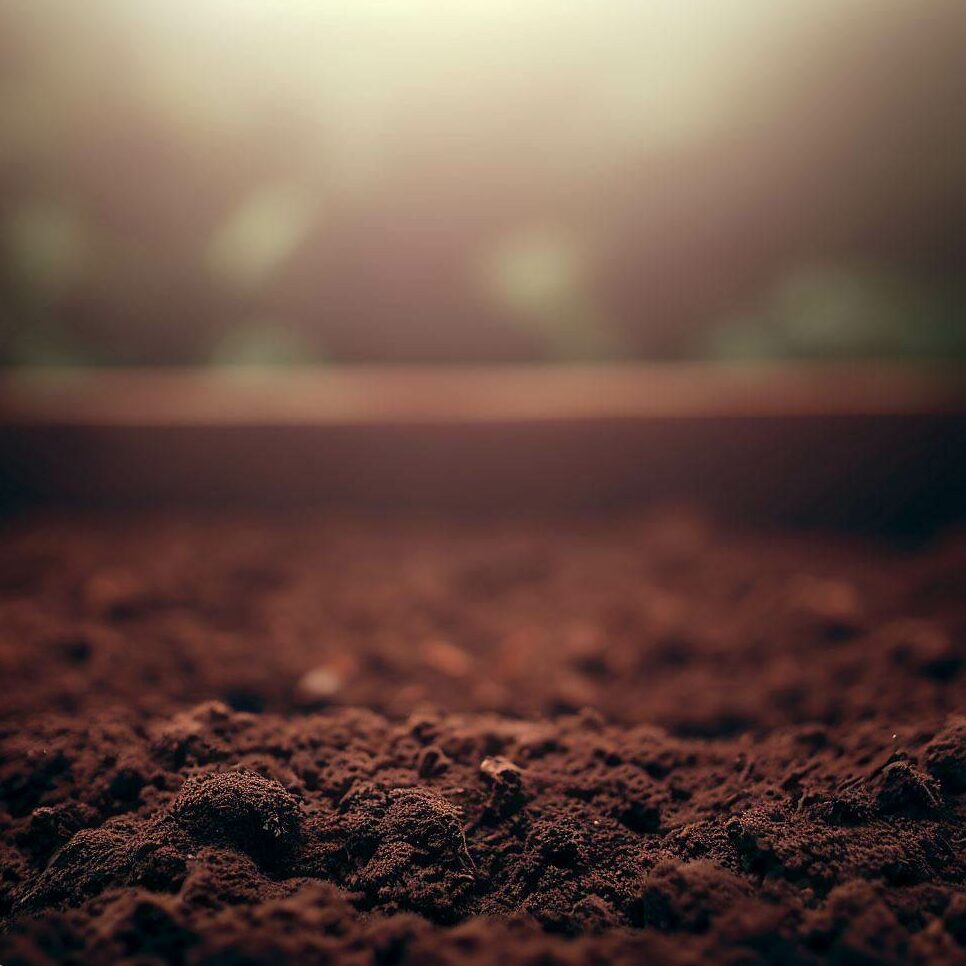
Preparing Your Raised Bed
Now, let’s talk about how to prepare your raised bed for planting. Here are some steps to follow:
- Measure Your Bed: Before you start, you’ll want to know “how deep should a raised bed be for carrots”. Ideally, your raised bed should be at least 12 inches deep. This gives your carrots plenty of room to grow and helps improve drainage.
- Remove Any Debris: Clear your bed of any rocks, sticks, or other debris that could hinder your carrots’ growth.
- Add Your Soil: Fill your raised bed with your chosen soil, making sure it’s loose and well-draining.
- Amend Your Soil: If needed, amend your soil with organic matter to improve its texture and nutrient content.
- Water Your Soil: Give your soil a good watering before you plant your seeds. This helps settle the soil and ensures it’s moist for your seeds.
🥕 Carrot Clues: Remember, carrots love loose, sandy soil. If your soil is too heavy or compacted, your carrots may end up short and stumpy. 🥕
So there you have it, the lowdown on preparing your soil for growing carrots in raised beds. With the right preparation, your soil will be ready to support a bumper crop of delicious, home-grown carrots.
Planting the Seeds
Now that your soil is ready, it’s time to plant your carrot seeds. This is where the magic really begins, as you start the process of turning tiny seeds into delicious, home-grown carrots.
The Art of Planting Carrot Seeds
Planting carrot seeds isn’t just about sticking them in the ground and hoping for the best. It’s a delicate process that requires care and attention. But don’t worry, with a little knowledge and patience, you’ll be a carrot-planting pro in no time.
Here’s a step-by-step guide to planting your carrot seeds:
- Soften the Seed Coat: Carrot seeds have a hard seed coat that needs to be softened for good germination. You can do this by soaking your seeds in water for about 24 hours before planting.
- Plant the Seeds: Once your seeds are ready, it’s time to plant. Make shallow grooves in your soil about 2cm deep and sow your seeds. Try to space them about 1 to 2 inches apart to give them room to grow.
- Cover the Seeds: Gently cover your seeds with soil. Remember, carrot seeds are tiny, so they don’t need to be buried deep. A light covering of soil is all they need.
- Water the Seeds: After planting, give your seeds a good watering. This helps settle the soil and provides the moisture your seeds need to germinate.
🥕 Carrot Clues: Remember, consistency is key when it comes to watering. Keep the soil consistently moist until your seedlings are up. 🥕
Growing Carrots from Seed in Containers
If you’re short on space, don’t worry, you can still grow your own carrots. Growing carrots from seed in containers is a great option for those with limited gardening space. The process is similar to planting in raised beds, but there are a few extra considerations to keep in mind.
- Choose the Right Container: Carrots need room to grow, so choose a deep container to accommodate their roots.
- Use Quality Soil: Just like in raised beds, carrots prefer loose, sandy soil. Make sure your container is filled with high-quality soil that drains well.
- Water Regularly: Containers can dry out faster than raised beds, so you’ll need to water your carrots more frequently. Keep the soil consistently moist, but avoid overwatering.
Whether you’re planting in raised beds or containers, growing carrots from seed is a rewarding process. With a little care and attention, you’ll be enjoying your own home-grown carrots in no time.
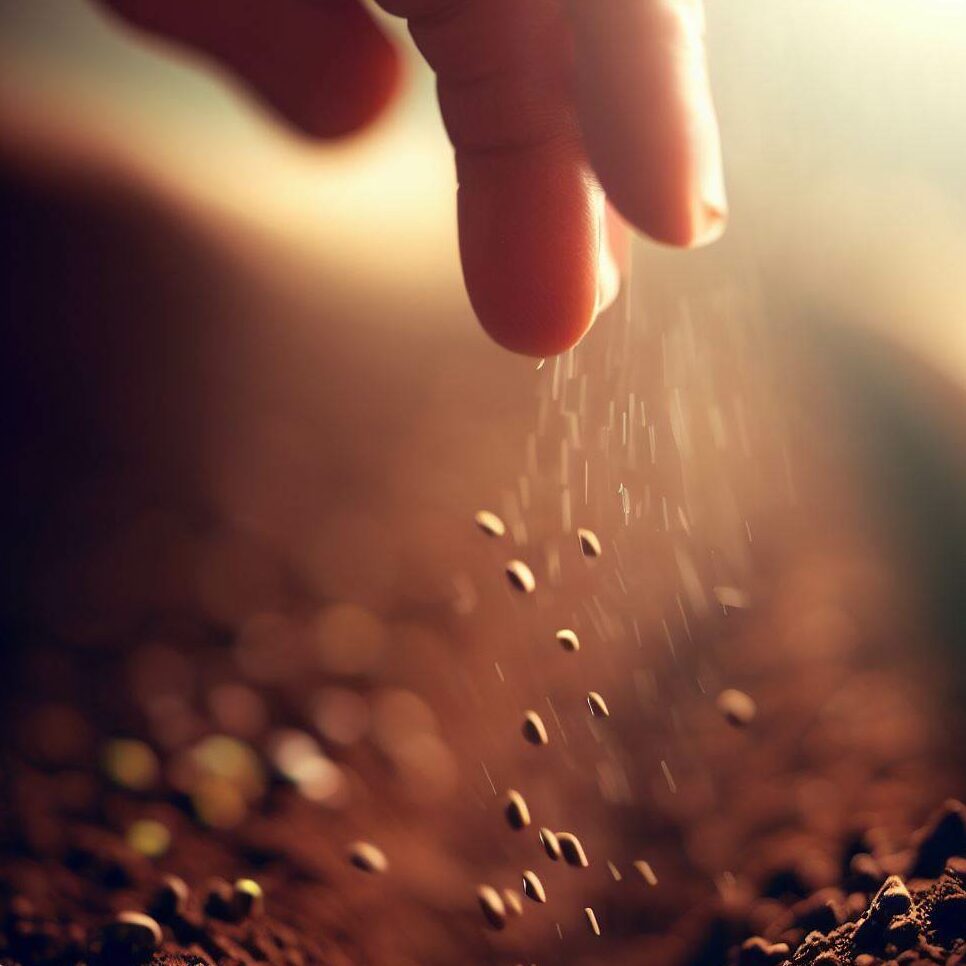
Caring for the Plants
Once your carrot seeds are planted and starting to grow, the next step is to care for your plants. This involves thinning out seedlings, watering, and monitoring for pests and diseases. Let’s dive into each of these aspects.
Thinning Out Seedlings
After your carrot seeds have sprouted, you might notice that they’re a little crowded. This is where thinning comes in. Thinning out your seedlings means removing some plants to give the remaining ones more space to grow.
Here’s how to thin out your carrot seedlings:
- Wait for the Right Time: Start thinning when your carrot seedlings are about 2 inches tall.
- Select the Strongest Seedlings: Choose the healthiest-looking seedlings to keep and remove the weaker ones.
- Be Gentle: Pull out the unwanted seedlings gently to avoid disturbing the roots of the remaining plants.
🥕 Carrot Clues: Don’t throw away the thinned seedlings! They’re perfectly edible and make a tasty addition to salads. 🥕
Watering Your Carrots
One of the most common questions gardeners have is, “how often do you water carrots in a raised bed?” The answer is that it depends on the weather and the moisture level of your soil. However, a good rule of thumb is to water your carrots about 1 inch per week.
Here are some tips for watering your carrots:
- Water Deeply: It’s better to water deeply and less frequently than to give your carrots a little water every day. Deep watering encourages the roots to grow down into the soil.
- Keep the Soil Moist: Carrots need consistently moist soil to grow well. If the soil dries out, your carrots may split or become stunted.
- Water in the Morning: Watering in the morning gives the water a chance to soak into the soil before the heat of the day causes it to evaporate.
🥕 Carrot Clues: Use a soaker hose or drip irrigation system to water your carrots. These methods deliver water directly to the soil, reducing evaporation and keeping the foliage dry, which can help prevent disease. 🥕
Caring for your carrot plants may require a bit of work, but it’s worth it when you harvest your own home-grown carrots. With proper thinning and watering, your carrots will be well on their way to becoming a tasty addition to your meals.
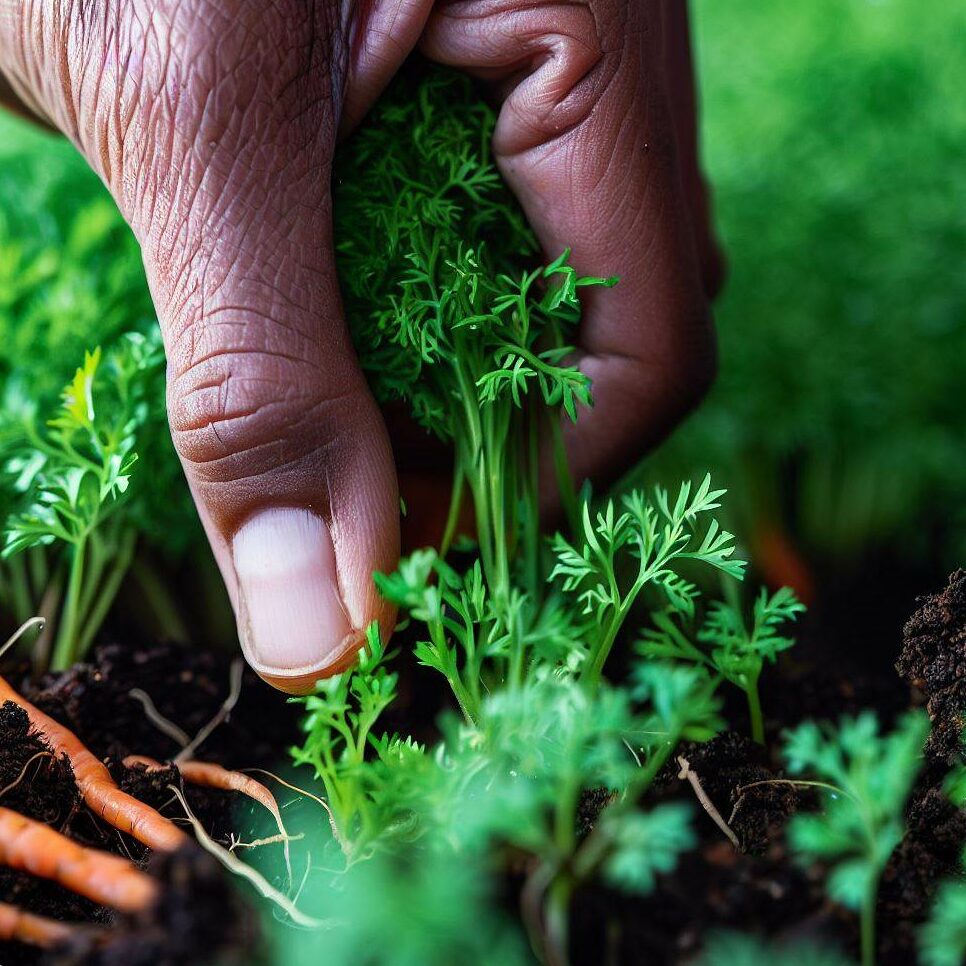
Harvesting the Carrots
After all your hard work preparing the soil, planting the seeds, and caring for the plants, it’s finally time to reap the rewards of your labor. Harvesting carrots is a straightforward process, but there are a few things to keep in mind to ensure you get the best yield.
When to Harvest Carrots
Carrots can be harvested when they are of suitable size, usually about 1/2 to 3/4 inch in diameter. You can usually start harvesting carrots 70 to 80 days after planting, but the exact time can vary depending on the variety and growing conditions.
Here are some signs that your carrots are ready to harvest:
- Size: Check the size of the carrot at the top of the soil. If it looks big enough, it’s probably ready to harvest.
- Color: Carrots should be a vibrant orange when they’re ready to harvest. If they’re still pale, they may need more time.
- Foliage: The tops of the carrots, or the foliage, should be vibrant and healthy-looking when the carrots are ready to harvest.
🥕 Carrot Clues You can harvest a few carrots at a time as you need them. Just be sure to harvest all your carrots before the first hard frost in the fall. 🥕
How to Harvest Carrots
Harvesting carrots is a simple process. Here’s how to do it:
- Loosen the Soil: Use a garden fork to gently loosen the soil around the carrots.
- Pull Gently: Grasp the carrot tops and pull gently. If the soil is loose, they should come right out.
- Remove Tops: Cut off the tops of the carrots to prevent them from drawing out moisture and making the carrots go limp.
- Store Properly: Store your harvested carrots in a cool, dark place to keep them fresh.
🥕 Carrot Clues: If your carrots are not growing well in your raised bed, it could be due to compacted soil, lack of water, or pests. Make sure your soil is loose and well-drained, water regularly, and keep an eye out for pests like carrot flies. 🥕
Harvesting your own carrots is a rewarding experience. With these tips, you’ll be well on your way to enjoying your own home-grown carrots in no time.
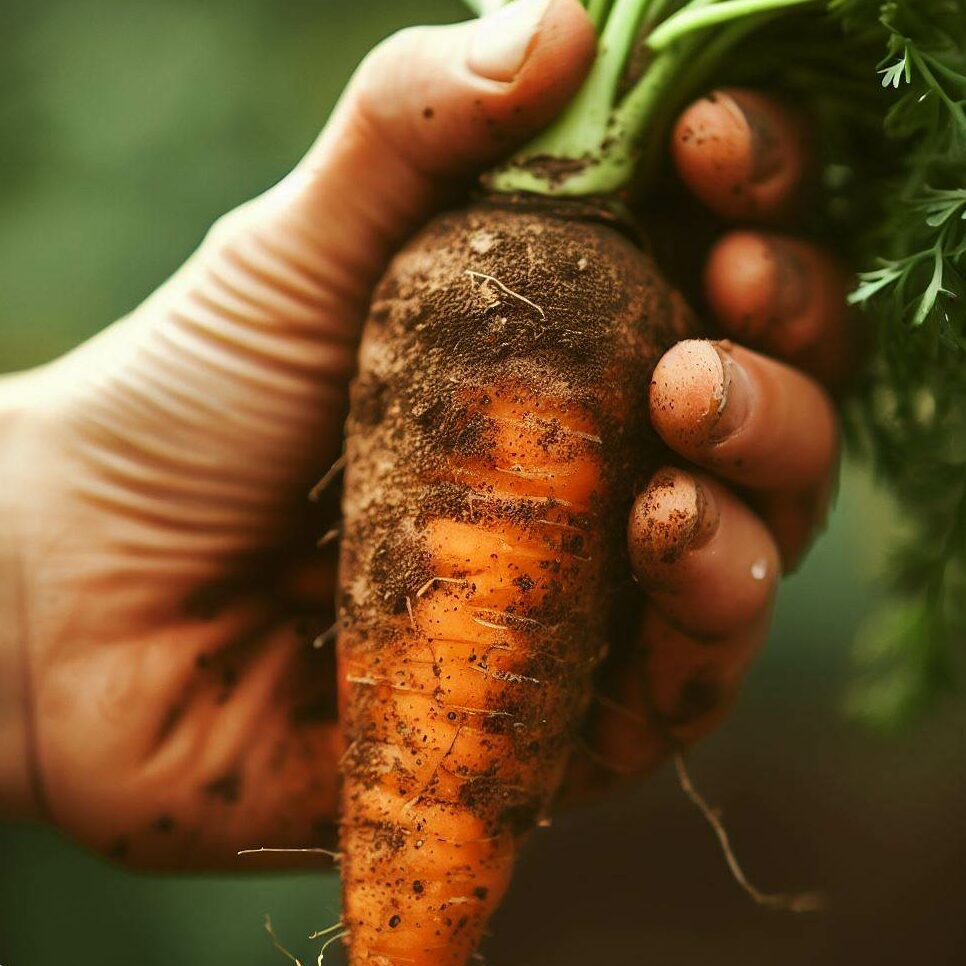
Additional Tips for Success
Now that you’re familiar with the basics of growing carrots in raised beds, let’s explore some additional tips that can help you achieve even greater success. From the benefits of container gardening to the best companion plants for carrots, these tips will help you make the most of your carrot growing experience.
Growing Carrots in Containers
Growing carrots in containers is a fantastic option if you’re short on space or if your garden soil is heavy clay or rocky. Containers offer excellent drainage, and because you can control the soil quality, you can create the perfect environment for your carrots. Plus, containers can be placed on patios, balconies, or even indoors, making it possible to grow carrots just about anywhere.
🥕 Carrot Clues: Choose a deep container to accommodate the carrot’s long roots and use a light, sandy potting mix for best results. 🥕
Best Carrots to Grow in Raised Beds
While all carrots can be grown in raised beds, some varieties are particularly well-suited to this method. Shorter varieties like ‘Paris Market’ and ‘Romeo’ are excellent choices for raised beds, especially if the beds aren’t very deep. For deeper beds, longer varieties like ‘Nantes’ and ‘Imperator’ can be grown successfully.
Companion Plants for Carrots
Companion planting is a method of growing plants together for mutual benefit. For carrots, good companion plants include tomatoes, which can provide shade and help retain moisture in the soil, and onions, which can deter carrot flies. Other good companions for carrots include beans, leeks, and radishes.
🥕 Carrot Clues: Avoid planting carrots near dill or parsnips, as they can attract pests that are harmful to carrots. 🥕
With these additional tips, you’re well on your way to becoming a carrot-growing expert. Remember, the key to success is good preparation, regular care, and a little bit of patience. Happy gardening!
Conclusion
In this comprehensive guide, we’ve explored the ins and outs of growing carrots in raised beds. From preparing the soil and planting the seeds to caring for the plants and harvesting the carrots, we’ve covered every step of the process. We’ve also shared additional tips for success, including the benefits of container gardening and the best companion plants for carrots.
Now it’s your turn to put this knowledge into practice. With a little bit of preparation and care, you can enjoy a bountiful harvest of homegrown carrots. So why wait? Start your carrot-growing journey today!
